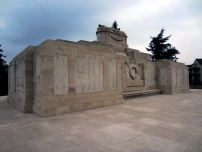| First Name: | William | Last Name: | CORSHAM | |
|---|---|---|---|---|
| Date of Death: | 17/09/1914 | Lived/Born In: | Ilford | |
| Rank: | Private | Unit: | Northamptonshire1 | |
| Memorial Site: | 1. East Ham, Central Park Memorial 2. La Ferte-sous-Jouarre Memorial, France | |||
Current Information:Born & Enlisted-Ilford
The Battle of the Aisne 13th September -28 September, 1914 After the Germans were defeated on the Marne they fell back to the River Aisne, closely pursued by both the British and the French. The new German line was a very formidable defensive position. To attack it meant having to cross the Aisne and then climb up a 500 foot high ridge on top of which was the Chemin des Dames, a road that gave the Germans an easy way to move troops along the top of the hills. On 13th September the Aisne was crossed by both British and French troops but after that progress became slower, until there was no progress at all. Both sides dug in and the fighting settled down into trench warfare. The fighting on the Aisne continued for two weeks at the end of which both sides realised that frontal attacks on entrenched positions were both costly and non-productive, not that this deterred them from continuing with this tactic throughout the war. At 3am on 14th September, 1914, 2 Brigade of 1st Division and two batteries of artillery moved off to capture the top of the Chemin des Dames ridge from Cerny to Courtecon. At 6.30am 2nd Sussex moved up and deployed on the left of 2nd King’s Royal Rifle Corps with each battalion holding about 800 yards of front. Meanwhile two companies of the 1st Northamptonshire battalion had moved to the next spur on the east so as to be able to bring fire on to the Germans. From here, according to the battalion diary, they attacked Hill IV of Noyon village and suffered some casualties while doing so. That night the other two companies moved up to fill gaps in the line but 1st Northamponshire, along with the rest of the BEF, found themselves unable to progress much further against an enemy in entrenched positions and they too had no option but to dig in themselves in the face of rifle, machine-gun and artillery fire.
On 17 September, the Germans kept up a heavy bombardment for three hours on the part of the line held by 1st Division during which time they then sent forward a company, under cover of mist and rain, to an abandoned trench from which they could enfilade the British line. 1st Queens and 1st Northamptonshire, supported by 2nd King’s Royal Rifle Corps were ordered to turf them out and 1st Northamptonshire crept forward unnoticed and in one rush cleared, the trench. A group of Germans, led by two officers, approached 2nd King’s Royal Rifle Corps with rifles slung and hands up. Rising to meet them some of 2nd King’s Royal Rifle Corps were shot by the Germans firing from the hip and several were wounded. When some 300-400 of the enemy tried this again against 1st Northamptonshire, the machine-guns of 2nd King’s Royal Rifle Corps mowed them down almost to a man. But there was a price to pay. Between them, 1st Queens and 1st Northamptonshire suffered 200 casualties, one of whom was William Corsham.
|
||||
| « Back to Search Results | ||||
| If you think any of the information shown here is incorrect, Click Here to submit your amends and comments | ||||




